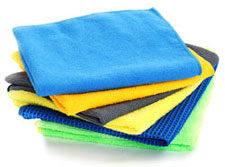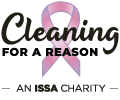Articles
Maximize Your Microfiber
Categories: Cleaning Best Practices, Innovations, Trends & Technology
By Jennifer Meek | May 8, 2018 << Back to Articles
According to a report by the University of Washington Department of Environmental and Occupational Health Sciences, microfiber cloths are more effective than traditional cotton cloths for removing bacteria from surfaces.* This study also suggests that microfiber products can help minimize cross-contamination, especially if a color-coded cleaning system is in place or if the microfiber can be properly folded into quadrants so that an unsoiled part of the cloth can be used when cleaning multiple surfaces.
When it comes to mopping floors, the report referenced other studies that found that microfiber mop heads reduced the amount of bacteria on tested floor surfaces by as much as 99 percent compared to 30 percent for traditional cotton-loop mops.
Microfiber dates back to the 1970s. Its fibers are measured in deniers, which refers to the thinness of the fiber. Microfiber is typically 1.0 denier or thinner; the thinner or smaller the denier measurement, the finer and more effective the microfiber.
This means that not all microfiber is alike. In fact, microfiber cloths can vary considerably. Recently, manufacturers have developed microfiber products with different weaves and densities, so cleaning professionals need to perform due diligence to select the type and quality of microfiber that will meet their specific needs.
But no matter what type or quality of microfiber you select, it must be properly cleaned, washed, and cared for to ensure it works and cleans effectively. It is especially important to know that microfiber products are highly porous. As their pores become soiled, their effectiveness diminishes.
Proper Care Procedures
As to proper—or improper, to be more exact—care, one of the most detrimental things users can do is to wash microfiber cloths or mop heads using fabric softeners. In these cases, the microfiber may hold chemical softeners in the pores of the product, preventing the microfiber from performing effectively.
Another mistake is to wash microfiber with other cloths, mop heads, or even clothing. The lint from the other fabrics sheds, and as it does, it may attach to the microfiber and clog its pores. Invariably, manufacturers will recommend that microfiber be washed separately with no other items in the washing machine.
Consider these additional guidelines for properly caring for microfiber and avoiding cleaning mistakes:
- Microfiber cloths and mop heads do not have to be washed after each use. For instance, if they are used for dusting, they can be shaken outside to remove dust and soils or hand-rinsed in warm water.
- Bleach and ammonia should not be used to wash microfiber as they can shorten the life of the product.
- Cold- or warm-water washing should be sufficient under normal circumstances. If the microfiber is excessively soiled, hot water can help expand the pores in the product and remove deeply embedded soils.
- Hot dryers should not be used to dry microfiber products. A low-heat or cool setting will help protect the fibers and prevent shrinkage. Alternately, cloths can be hung and air dried.
- Selecting the proper detergent is critical to protect the microfiber and extend its usefulness. Select an institutional laundry detergent specifically made for cleaning microfiber products. Along with being specially made for cleaning microfiber, these laundry products will have no softeners and little to no bleach.
- Microfiber does not need to be ironed. In fact, ironing can damage the fibers and should be avoided.
On top of being more effective at cleaning, one of the other significant benefits of microfiber products is longevity. A typical cotton cloth can be washed up to 100 times—often less—before it begins to tear and shred. In comparison, some microfiber products can be washed as many as 500 times or more. This is important to know because higher quality microfiber products tend to cost more than conventional cotton products; however, their cleaning effectiveness and enhanced life span typically make them more cost-effective in the long run.
* University of Washington School of Public Health Department of Environmental and Occupational Health Sciences Field Research and Consultation Group, Dr. Marilyn C. Roberts Laboratory Seattle, WA, August 2012

About the Author.
Jennifer Meek is the director of marketing for Charlotte Products, manufacturers of professional cleaning and green cleaning products. She may be reached via her company website at www.charlotteproducts.com.





